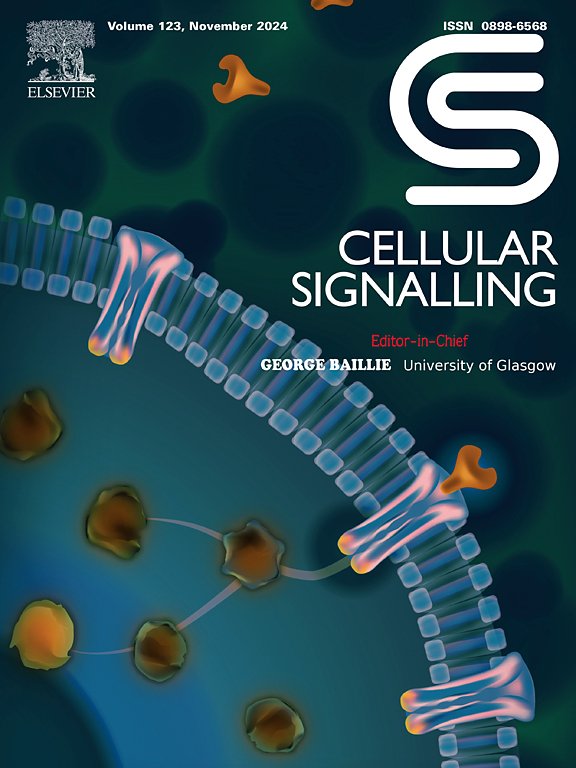糖尿病椎间盘退变的调控:AGEAT/miR-204-5p/Mapk4轴在髓核细胞线粒体功能和凋亡中的作用
IF 3.7
2区 生物学
Q2 CELL BIOLOGY
引用次数: 0
摘要
伴有椎间盘退变(IVDD)的慢性腰痛在糖尿病(DM)患者中明显加重;然而,潜在的分子机制尚不清楚。本研究探讨了长链非编码RNA AGEAT (AGE-associated transcript)在dm相关IVDD发病机制中的作用。用晚期糖基化终产物(AGEs)处理的大鼠髓核细胞(npc)的全转录组测序显示AGEAT的时间依赖性上调。AGEAT过表达诱导鼻咽癌细胞凋亡、线粒体功能障碍和细胞外基质(ECM)降解。在机制上,RNA荧光原位杂交将AGEAT定位到细胞质上,通过直接结合miR-204-5p,它作为竞争的内源性RNA (ceRNA),从而缓解其靶Mapk4的抑制。通过siRNA沉默AGEAT可显著减少细胞凋亡,恢复线粒体功能,并保持ECM完整性。在体内,糖尿病IVDD大鼠椎间盘内注射AAV-sh-AGEAT可显著改善椎间盘完整性,MRI Pfirrmann分级降低,组织学上保留了NPC密度和II型胶原含量。总的来说,这些发现表明AGEAT是通过miR-204-5p/Mapk4轴加重糖尿病IVDD的关键ceRNA,促进鼻咽癌细胞凋亡、线粒体功能障碍和ECM降解。靶向这一途径——通过AGEAT沉默或miR-204-5p激活——是缓解糖尿病相关椎间盘退变的一种有希望的治疗策略。这项研究揭示了AGEAT/miR-204-5p/Mapk4轴在dm相关IVDD进展中的关键作用,提出了一种潜在的治疗策略。本文章由计算机程序翻译,如有差异,请以英文原文为准。

Regulation of diabetic disc degeneration: The role of AGEAT/miR-204-5p/Mapk4 axis in nucleus pulposus cells' mitochondrial function and apoptosis
Chronic low back pain associated with intervertebral disc degeneration (IVDD) is significantly aggravated in patients with diabetes mellitus (DM); however, the underlying molecular mechanisms remain unclear. This study explored the role of the long non-coding RNA AGEAT (AGE-associated transcript) in the pathogenesis of DM-associated IVDD. Whole-transcriptome sequencing of rat nucleus pulposus cells (NPCs) treated with advanced glycation end products (AGEs) revealed a time-dependent upregulation of AGEAT. AGEAT overexpression induced NPC apoptosis, mitochondrial dysfunction, and extracellular matrix (ECM) degradation. Mechanistically, RNA fluorescence in situ hybridization localized AGEAT to the cytoplasm, where it acted as a competing endogenous RNA (ceRNA) by directly binding miR-204-5p, thereby relieving repression of its target Mapk4. Silencing AGEAT via siRNA significantly reduced apoptosis, restored mitochondrial function, and preserved ECM integrity. In vivo, intra-discal injection of AAV-sh-AGEAT in diabetic IVDD rats significantly improved disc integrity, as evidenced by a reduction in MRI Pfirrmann grade and histological preservation of NPC density and collagen II content. Collectively, these findings establish AGEAT as a key ceRNA that exacerbates diabetic IVDD via the miR-204-5p/Mapk4 axis, promoting NPC apoptosis, mitochondrial dysfunction, and ECM degradation. Targeting this pathway—through AGEAT silencing or miR-204-5p activation—represents a promising therapeutic strategy for mitigating diabetes-associated disc degeneration. This study reveals the critical role of the AGEAT/miR-204-5p/Mapk4 axis in the progression of DM-associated IVDD, suggesting a potential therapeutic strategy for its treatment.
求助全文
通过发布文献求助,成功后即可免费获取论文全文。
去求助
来源期刊

Cellular signalling
生物-细胞生物学
CiteScore
8.40
自引率
0.00%
发文量
250
审稿时长
27 days
期刊介绍:
Cellular Signalling publishes original research describing fundamental and clinical findings on the mechanisms, actions and structural components of cellular signalling systems in vitro and in vivo.
Cellular Signalling aims at full length research papers defining signalling systems ranging from microorganisms to cells, tissues and higher organisms.
 求助内容:
求助内容: 应助结果提醒方式:
应助结果提醒方式:


